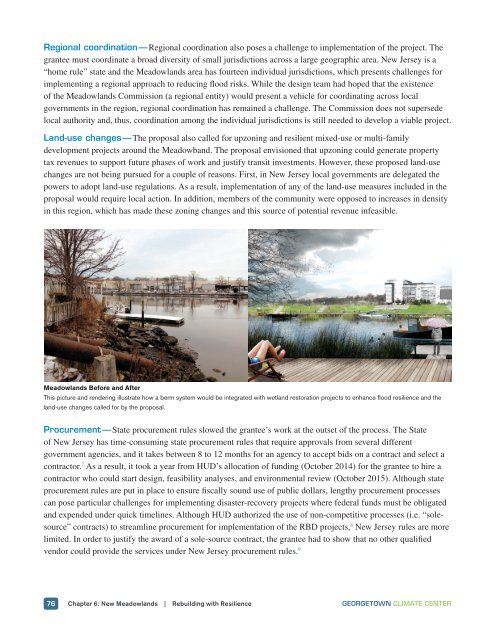Rebuilding with Resilience
dw0r306aHfX
dw0r306aHfX
You also want an ePaper? Increase the reach of your titles
YUMPU automatically turns print PDFs into web optimized ePapers that Google loves.
Regional coordination — Regional coordination also poses a challenge to implementation of the project. The<br />
grantee must coordinate a broad diversity of small jurisdictions across a large geographic area. New Jersey is a<br />
“home rule” state and the Meadowlands area has fourteen individual jurisdictions, which presents challenges for<br />
implementing a regional approach to reducing flood risks. While the design team had hoped that the existence<br />
of the Meadowlands Commission (a regional entity) would present a vehicle for coordinating across local<br />
governments in the region, regional coordination has remained a challenge. The Commission does not supersede<br />
local authority and, thus, coordination among the individual jurisdictions is still needed to develop a viable project.<br />
Land-use changes — The proposal also called for upzoning and resilient mixed-use or multi-family<br />
development projects around the Meadowband. The proposal envisioned that upzoning could generate property<br />
tax revenues to support future phases of work and justify transit investments. However, these proposed land-use<br />
changes are not being pursued for a couple of reasons. First, in New Jersey local governments are delegated the<br />
powers to adopt land-use regulations. As a result, implementation of any of the land-use measures included in the<br />
proposal would require local action. In addition, members of the community were opposed to increases in density<br />
in this region, which has made these zoning changes and this source of potential revenue infeasible.<br />
Meadowlands Before and After<br />
This picture and rendering illustrate how a berm system would be integrated <strong>with</strong> wetland restoration projects to enhance flood resilience and the<br />
land-use changes called for by the proposal.<br />
Procurement — State procurement rules slowed the grantee’s work at the outset of the process. The State<br />
of New Jersey has time-consuming state procurement rules that require approvals from several different<br />
government agencies, and it takes between 8 to 12 months for an agency to accept bids on a contract and select a<br />
contractor. 7 As a result, it took a year from HUD’s allocation of funding (October 2014) for the grantee to hire a<br />
contractor who could start design, feasibility analyses, and environmental review (October 2015). Although state<br />
procurement rules are put in place to ensure fiscally sound use of public dollars, lengthy procurement processes<br />
can pose particular challenges for implementing disaster-recovery projects where federal funds must be obligated<br />
and expended under quick timelines. Although HUD authorized the use of non-competitive processes (i.e. “solesource”<br />
contracts) to streamline procurement for implementation of the RBD projects, 8 New Jersey rules are more<br />
limited. In order to justify the award of a sole-source contract, the grantee had to show that no other qualified<br />
vendor could provide the services under New Jersey procurement rules. 9<br />
76 Chapter 6: New Meadowlands | <strong>Rebuilding</strong> <strong>with</strong> <strong>Resilience</strong> GEORGETOWN CLIMATE CENTER


